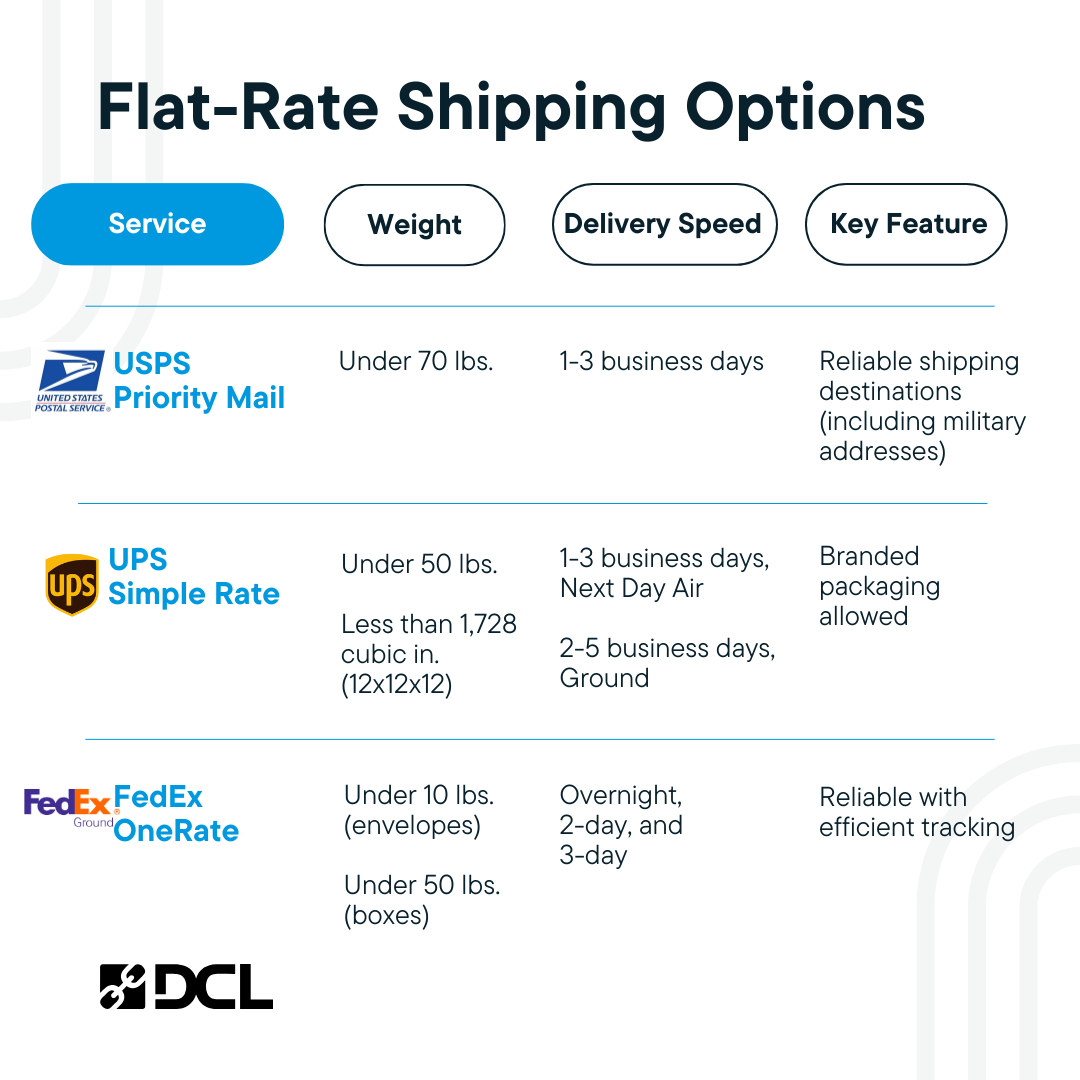
Comparing Flat-Rate Shipping Options – FedEx One Rate, USPS Priority Mail Flat Rate, and UPS Simple Rate
Many ecommerce shippers are looking for ways to lower their overall shipping costs. One popular option, especially among small businesses and those looking to streamline their operations is flat-rate shipping.
Many major carriers offer a flat-rate option, but not all. It’s important to weigh your product features and customer needs before switching shipping services.
Here is a detailed overview of FedEx One Rate, USPS Priority Mail Flat Rate, and UPS Simple Rate.
What is Flat-rate Shipping?
Most carriers offer a flat-rate shipping service in which the cost of shipping is determined by the packaging (often provided by the carrier), rather than the dimensions, weight, or DIM of the shipment.
While flat-rate services vary between carriers, most need to be shipped in a very specific way to qualify for the flat-rate. These specifications include pre-determined packaging, size restrictions (must fit within the pre-determined package), weight restrictions, distance (many flat-rate services designate the shipping zones that are allowed—most specify within the contiguous US).
For ecommerce brands using flat-rate options for small parcel shipping, here are the distinguishing features:
- Simplified packaging
- Consistent shipping costs
- Products may not be as secure due to limited box sizes and shapes
- Boxes or envelopes are not usually branded
Products that are Best Suited for Flat-Rate Shipping
Not all packages will be cost-efficient with flat-rate shipping. The following attributes will be best for a flat-rate option.
- Products that are relatively small and heavy.
- High volume of orders that need to go across many shipping zones (e.g.: from West Coast to East Coast)
- You need a fixed shipping cost (for customers or your shipping budget)
- An overall low volume of orders coupled with in-house order fulfillment. The convenience of flat rate shipping, plus free packaging from the carrier, may be a net savings for your business.

How Long Does Flat Rate Shipping Take?
The delivery speed is important to consider for products that customers expect quickly. Flat-rate shipping services can have variable delivery speeds. Here are some details about how each carrier handles flat-rate delivery speeds.
- FedEx OneRate—options are limited to FedEx Express which includes overnight, 2-day, and FedEx Express Saver. FedEx Ground is not included.
- UPS—options offered include Ground, 3-Day Select, and 2nd Day Air.
- USPS Priority Mail—all packages have a 3-day delivery window (sometimes quicker) no matter the shipping zones they cover.
An Overview of Flat-Rate Shipping Services and Their Advantages
When comparing flat-rate services, it’s important to consider the characteristics of your packages. The shipping speed, destination coverage, packaging options, and cost should be at the forefront of your considerations.
Additionally, carriers may have specific terms and conditions, restrictions, and additional services that may influence your decision.
FedEx One Rate
- Eligible Packaging: FedEx Express packaging options (envelopes, boxes, tubes).
- Coverage: Domestic shipments within the United States only.
- Weight limit: Under 10 lbs. (envelopes), under 50 lbs. (boxes).
- Shipping Speeds: Offers overnight, 2-day, or 3-day delivery services.
- Key Features: FedEx One Rate charges by distance. The higher the shipping zone of the destination, the higher the cost to ship with One Rate.
Get a full overview of the FedEx One Rate program and details about each package type.
USPS Priority Mail and Priority Mail Express
- Eligible Packaging: USPS Flat Rate boxes and envelopes.
- Coverage: Domestic shipments within the United States, and certain U.S. territories and military addresses.
- Weight: Under 70 lbs.
- Shipping Speeds: 1-3 business days.
- Key Advantage: Simple and straight-forward service with reliable shipping destinations (including military addresses).
Full details on USPS flat-rate shipping, their pricing structure and box dimensions for flat-rate options.
UPS Simple Rate
- Eligible Packaging: Use your own packaging or UPS boxes and envelopes.
- Coverage: Domestic shipments within the United States. There is one rate for anywhere in the contiguous US. A higher rate is added for Alaska and Hawaii.
- Weight and size limits: Under 50 lbs. Less than 1,728 cubic in. (the equivalent of 12 x 12 x 12).
- Shipping Speeds: 1-3 business days for UPS Simple Rate Next Day Air and 2-5 business days for UPS Simple Rate Ground.
- Key Advantage: Destination and weight don’t affect pricing. Using your own packaging can help your brand stand out from the rest.
More information on UPS Simple Rate and their flat-rate shipping services.

Benefits of Flat Rate Shipping for Ecommerce Brands
Choosing flat-rate shipping for ecommerce offers many benefits:
- More predictable shipping costs—with surcharges and last-minute changes from carriers, flat rate shipping allows for less cost fluctuations.
- Lower cart abandonment rates—if you only use flat-rate shipping your customers will have a smoother, faster checkout because they’ll have less clicks and less decision-making to do.
- Potential to generate higher revenue per order—if customers have one single rate for shipping, they may increase their cart size to ensure they’re getting multiple products for a single shipping rate.
- Potential to bring in new customers—single-rate shipping can be a great promotional marketing tool to attract customers.
Bottom Line
Flat-rate shipping will make your shipping costs steadier, and often it will lower your overall rates. But before you jump into a flat-rate service, it’s critical to understand that you may run into issues as well. Returns may be processed slower, you may be subjected to service terms changes, parcel tracking may be limited compared to other services or carriers, and the service may not integrate with your other ecommerce platforms and programs as well.
This post was written by Maureen Walsh, Marketing Manager at DCL Logistics. A writer and blogging specialist for over 15 years, she helps create quality resources for ecommerce brands looking to optimize their business.

Tags: freight, Shipping carrier updates









